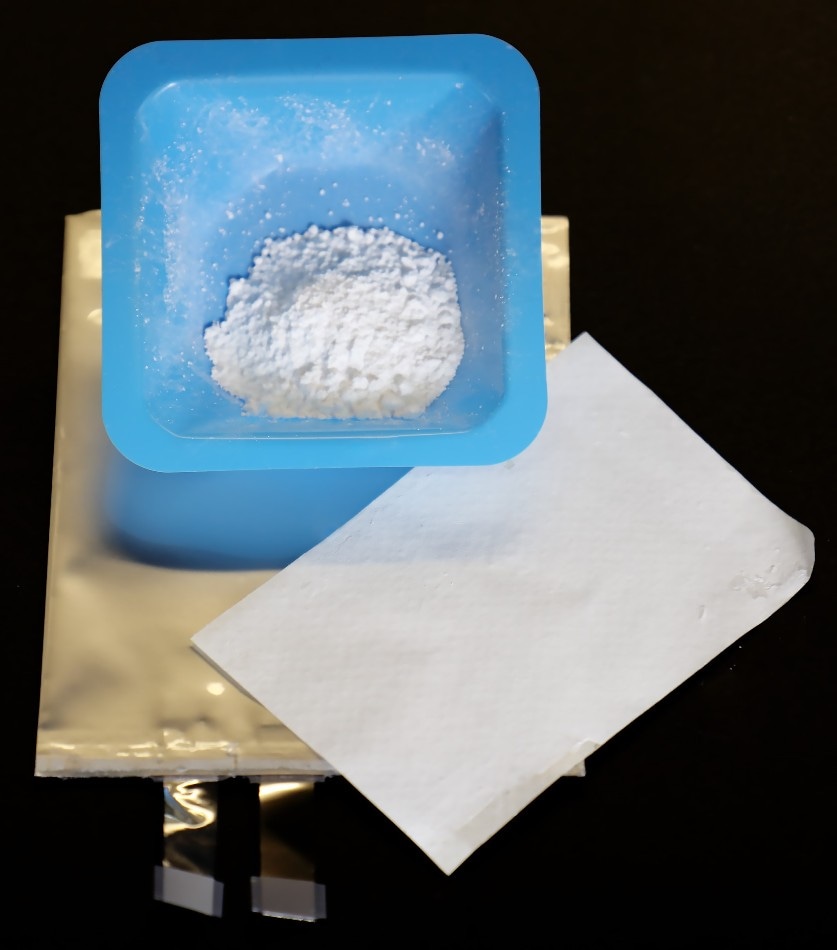Aug 24 2018
Lithium-ion batteries typically used in consumer electronics are infamous for bursting into flame when damaged or wrongly packaged. These incidents sometimes have serious consequences, including house fires, burns, and at least one plane crash. Inspired by the peculiar behavior of certain liquids that solidify on impact, scientists have developed a practical and economical method to help prevent these fires.
 Adding powdered silica (in blue container) to the polymer layer (white sheet) that separates electrodes inside a test battery (gold bag) will prevent lithium-ion battery fires. (Image credit: Gabriel Veith)
Adding powdered silica (in blue container) to the polymer layer (white sheet) that separates electrodes inside a test battery (gold bag) will prevent lithium-ion battery fires. (Image credit: Gabriel Veith)
Their results will be presented at the 256th National Meeting & Exposition of the American Chemical Society (ACS). ACS, the world’s largest scientific society, is hosting the meeting this week. It comprises over 10,000 presentations on a broad range of topics.
In a lithium-ion battery, a thin piece of plastic separates the two electrodes. If the battery is damaged and the plastic layer fails, the electrodes can come into contact and cause the battery’s liquid electrolyte to catch fire.
Gabriel Veith, Ph.D.
To make these batteries safer, some scientists switched to a nonflammable, solid electrolyte. But these solid-state batteries require major retooling of the present production process, Veith says. As a substitute, his team incorporated an additive into the conventional electrolyte to make an impact-resistant electrolyte. It solidifies when hit, thus stopping the electrodes from touching if the battery is damaged during a crash or fall. If the electrodes do not touch each other, the battery does not catch fire. Even better, adding the additive would require only slight modifications to the conventional battery manufacturing process.
The eureka moment of the project came when Veith and his kids were playing with a mixture of cornstarch and water called oobleck. “If you put the mixture on a cookie tray, it flows like a liquid until you start poking it, and then it becomes a solid,” says Veith, who is based at Oak Ridge National Laboratory and is the project’s chief investigator. Once the pressure is removed, the substance liquefies again. Veith understood he could manipulate this reversible “shear thickening” behavior to ensure batteries are safer.
This feature depends on a colloid, which is a suspension of miniature, solid particles in a liquid. In the case of oobleck, the colloid comprises cornstarch particles suspended in water. Veith and his colleagues at Oak Ridge and the University of Rochester used silica suspended in common liquid electrolytes for lithium-ion batteries to make the battery colloid. On impact, the silica particles cluster together and hinder the flow of fluids and ions, he explains. The scientists used flawlessly spherical, 200-nanometer-diameter particles of silica, or basically a superfine sand.
“If you have that very uniform particle size, the particles disperse homogeneously in the electrolyte, and it works wonderfully,” Veith says. “If they’re not homogenously sized, then the liquid becomes less viscous on impact, and that’s bad.”
Some other labs have been exploring shear thickening to make batteries safer. One team formerly reported on research with “fumed” silica, which comprises minute irregular particles of silica. Another team recently reported on the effect of employing rod-shaped silica particles. Veith believes his spherical particles might be easier to create than the rod-shaped silica and have a quicker response and more stopping power on impact compared to fumed silica.
One of Veith’s big advances includes the production process for the batteries. During production of traditional lithium-ion batteries, an electrolyte is jetted into the battery case at the end of the production process, which is followed by the battery being sealed. “You can’t do that with a shear-thickening electrolyte because the minute you try to inject it, it solidifies,” he says. The scientists solved this by setting the silica in place prior to incorporating the electrolyte. They are aiming to get a patent on their method.
Going forward, Veith plans to improve the system so the part of the battery that’s damaged in a crash would stay solid, while the rest of the battery would continue working. The team is firstly targeting applications such as drone batteries, but they would ultimately like to enter the automotive sector. They also plan to build a bigger version of the battery, which would be designed to stop a bullet. That could be advantageous for soldiers, who regularly carry 20 pounds of body armor and 20 pounds of batteries when they are on a mission, Veith says. “The battery would function as their armor, and that would lighten the average soldier by about 20 pounds.”
The project is being aided by the U.S. Department of Energy’s Advanced Research Projects Agency-Energy and Oak Ridge National Laboratory.